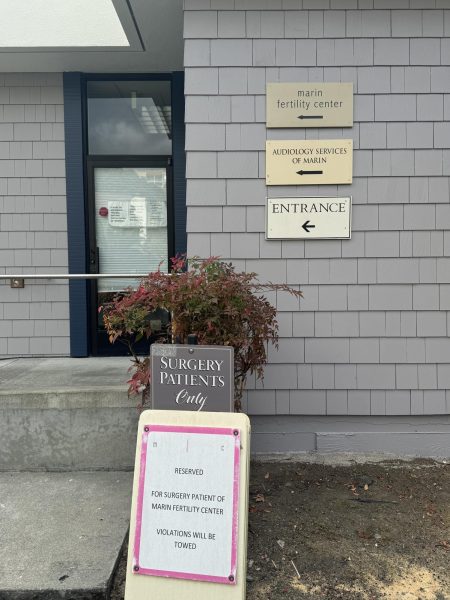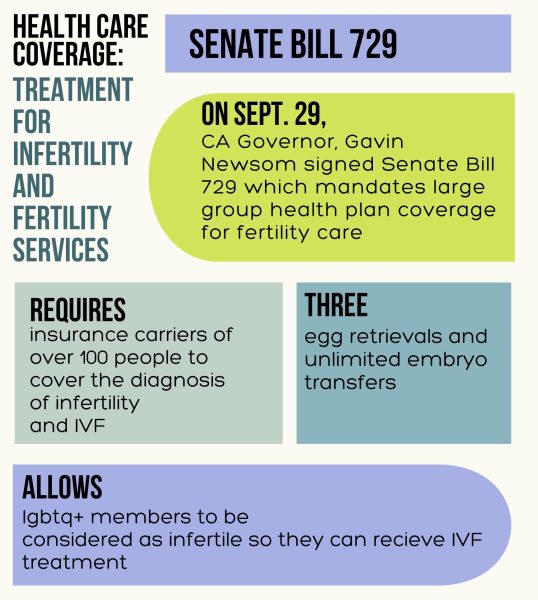On Sept. 29, Governor Gavin Newsom signed Senate Bill 729, a law requiring certain insurance carriers to cover in vitro fertilization (IVF). The bill will go into effect in July 2025 and aims to make reproductive health and building a family much more accessible and affordable for all Californians.
Charlotte Henderson, a sophomore and president of the Reproductive Freedom Club, feels that having the option of IVF is essential.
“I think people must be able to live their lives the way they want. People who face a natural barrier [like infertility,] IVF should be available to help them, and they should be able to have children if that’s what they want,” Henderson said.

Infertility, the failure to conceive a child after 12 months of unprotected intercourse, is a problem that millions face. Approximately 9 percent of women and 11 percent of men experience infertility in the United States, and 15 percent of couples in America also have trouble conceiving. This often leads people to IVF, the process in which eggs from the uterus are retrieved and fertilized by sperm in a lab before being put back in the uterus.
Senate Bill 729 mandates insurance companies that cover 100 people or more to cover the cost of infertility diagnosis and treatment, including IVF. Insurance companies must cover a maximum of three egg retrievals and unlimited embryo transfers. However, while the new law applies to large state-run insurance companies, it does not require religious insurers or Medi-Cal, an insurance plan for lower-income families, to cover the costs of IVF, leaving many still struggling with infertility.
The process of IVF has been gaining popularity. Between 2012 and 2021, the use of assisted reproductive technology (ART) more than doubled in the United States and accounted for 2.3 percent of all fetuses conceived in 2021. IVF is the main method of ART, making up 99 percent of procedures. However, IVF can be an emotional and expensive process.

Courtney Earl, a Redwood parent with one child conceived through IVF and two adopted children, shared her experience. Earl believes that the procedure was especially emotionally taxing because of the feelings of uncertainty and expectations from both herself and the people around her.
“There’s just a lot of sadness around [IVF]. You [can] feel like, ‘Why didn’t [conception] come easy for us?’ Especially since my mom had six kids, my oldest sister had four and my next sister had three; it just came easy for them, so it was sad when [the same] didn’t happen for us,” Earl said.
Earl also conveyed that the price tag was a big factor in the IVF process and had to be well thought out.
“There were definitely doubts. [My husband and I] were newly married and pretty young in our careers, and we had also just bought a house, so IVF was a huge investment given all the different things we were trying to do simultaneously,” Earl said.
High costs are a factor that many parents considering IVF face. The average cost of IVF in the United States ranges between $14,000 and $20,000. However, this price is only for one cycle of treatment. The average success rate after one cycle of IVF is extremely low, and it takes 65.3 percent of couples about six or more cycles before they can conceive, often bringing the price above $100,000.
In a written statement, Governor Newsom made clear the significance of having IVF covered by insurance and equal access to reproductive care, especially as IVF is not valued at the same level in other parts of the country.
“California is a reproductive freedom state. As a national leader in increasing access to reproductive health care and protecting patients and providers, including those under assault in other states, I want to be clear that the right to fertility care and IVF is protected in California. In many other states, this is not the case,” Newsom said.
The new law also expands equality for the LGBTQ+ community by changing the definition of infertility to include LGBTQ+ families, allowing same-sex couples access to IVF and a chance at starting a family without having to consider other methods of childbearing.
By expanding insurance coverage for IVF, California is now offering residents more reproductive opportunities and freedom than ever before.








